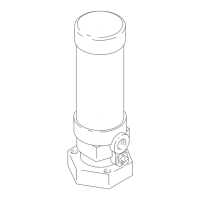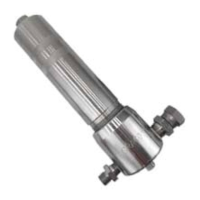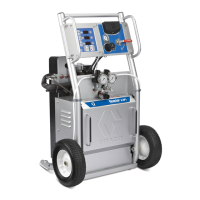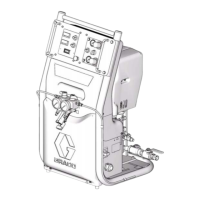EQUIPMENT MISUSE HAZARD
2
General Safety
Any
misuse of the spray equipment or accessories. such
as
overpressurizing. modifying parts, using incompatible chemi-
calsandfiuids,orusingwomordamagedparts,cancausethem
to
rupture and result in fluid injection, Splashing in the
eyes
or
on the skin, or other serious bodily injury, or fire, explosion or
property damage.
NEVER alter or modify any part of this equipment; doing
so
could cause it
to
malfunction.
CHECK ail spray equipment regularly and repair or replace
wom or damaged parts immediately.
Always wear protective eyewear, gloves. CiOthing and respirator
as recommended by the fluid and solvent manufacturer.
System Pressure
This sprayer can develop 3000
psi
(210 bar)
MAXIMUM
WORK-
ING
PRESSURE.
&
sure all spray equipment and accessories
used are rated
to
withstand
the
this pressure. DO NOTexceed
the maximum working pressure of any component or accessory
used in the system.
Fluid and Solvent Compatibility
Ailchemicaisusedinthesprayermustbechemicailycompatibie
with
the wetted
Dam
shown in the
TECHNICAL DATA
on Daae
~~~~ ~
.
~ ~~
3.
Consult your chemical supplier
to
ensure compatibility.
-
~~ ~ ~
High pressure fluid in the hoses can be very dangerous.
if
the
hose develops a leak, split or rupture due
to
any kind of wear,
damage or misuse, the high pressurespray eminad from it
can
cause a fluid Injection injury or other serious bodily injury or
property damage.
ALLFLUIDHOSESMUSTHAVESTRAINRELIEFSONBOTH
ENDS!
me
strain reliefs help protect the hose
from
kinks or
bendsatorclosetothecoupiingwhichcanresuitinhoserupture.
TIGHTEN all fluid connections securely before each use. High
pressure fluid
can
dislodge a loose coupling or aiiow high pres-
sure spray
to
be
emitted from the coupling.
NEVER use a damaged hose. Before each use, check the elltire
hose for cuts, leaks, abrasion, bulging cover, or damage or
movemenl of the hose couplings.
if
any of these conditions ex-
ist,
replace the hose immediately.
DO
NOT try
to
recouple high
pressure hose or mend
it
with tape or any other device.
A
re-
paired hose cannd contain the
high
pressure fluid.
hoses
to
move equipment. Keep
hoses clear
of
moving parts
HANDLE
AND
ROUTE HOSES CAREFULLY.
Do
not
puli
on
and hot surfaces of the pump and gas engine. Do
not
use fluids
or solvents which are
not
compatible with the inner tube and
coverofthehose.DON0TexposeGracohosestotemperatures
above
180'
F
(82"
C) or below
-40"
F
(-40'
C).
Hose Groundlng Continuity
Proper hose grounding continuity is essential
to
maintaining a
grounded spray
system.
Check the electrical
resistance
of your
fiuidhosesatleastonceaweek.Ifyourhosedoesnothaveatag
on
it
whichspecifiesthe maximumelectricai resistance,wntaCt
the hose supplier or manufacturer for the maximum resistance
limits.
Use
a resistance meter
in
the appropriate range for your
hose
to
check the resistance.
If
the resistance exceeds the rec-
ommended limits, replace it immediately.
An
ungrounded or
poorly grounded hose
can
make your
system
hazardous. Also
read
FIRE
OR
EXPLOSION HAZARD,
below.
Aiwaysreadthechemicai
manufacturer'sliteraturebeforeusing
them in this sDraver.
Static electricity is created by the flow of fluid through the pump
and hose.
if
every
pan
of the spray equipment is
not
properly
grounded. sparking may occur, and the
system
may become
hazardous. Sparking may also occur when plugging in or un-
piuggingapowersUpplyCOrdorUsingagasoiineengine.Sparks
canignitefumesfromsoiventsandthefiuidbeingsprayed,dust
particles and other flammable substances, whether you are
spraying indoors or outdoors. and
can
cause a fire or explosion
and serious bodily injury and property damage.
using this equipment,
STOP SPRAYING IMMEDIATELY.
If
you experience any static sparking
or
any slight shock while
system again until the problem is identified and corrected.
Check the entire system for proper grounding.
Do
not
use the
Grounding
To reduce the risk of static Sparking. ground the sprayer and ail
other spray equipment used or located in the spray area.
CHECK your iocai electrical
code
for detailed grounding
in-
structions for your area and
type
of equipment. BE SURE
to
ground ail of this spray equipment
1.
Sprayer: for mobile spraying, be sure the grounding chain
contacts the ground. For stationary spraying, connect a
ground wire and clamp (supplied)
to
a true earth ground.
GASOLINE ENGINE HAZARD
~~~~~~~~~~~~~
NEVER
fill
the fuel tank while the engine is running or hot. Fuel
spiiied
on
a hot surface can ignite and cause a flre.
ALWAYS pourfuei in slowly
to
avoidspiiling. Also read
FIRE
OR
EXPLOSION HWRD,
above, and
FUELING
on
page 11.
gine exhaust is piped outside. The exhaust contains carbon
NEVER operate the engine in a closed building unless the
en-
cause serious illness and even death of inhaled.
monoxide, a poisonous. odorless and invisible
gas
which can
2.
Fluid hoses:
use
only
grOunded hoses with
a
maximum
Of
500
fl
(150
m)
combined hose length
to
ensure grounding
continuity.
See
Hose Grounding Continuity
above.
3. Spray
gun:
obtain grounding through connection
to
a prop
eriy grounded fluid hose and sprayer.
4.
Object being sprayed: according to
local
code.
5. Fluid supply container: according
to
local code.
6.
Allsolventpailsused whenflushing, aCCOrdingt0 iocai
code.
Use only metal
pails,
which are conductive. Do not
piace
the
pail
on
a
non-conductive surface, such as paper or card-
board. which intenupts the grounding continuity.
7.
To
maintain grounding continuify when flushing
or
relieving
pressure,aiwayshoidametalpartofthegunfirmlytotheside
of a grounded metal pail. then trigger the gun.
~~
Flushing Safety
Reduce the risk
of
fluid injection injury, static sparking, or
Splashing by following the flushing pr&eiluregivenon page 13
of this manual. Follow the
PRESSURE RELIEF PROCEDURE
on
page
4,
and remove the spray tip before flushing. Hold
a
and use the
lowest possible fluid pressure during flushing.
metal part of
the gun firmly
to
the side
of
a grounded metal pail
United States Government safety standards have been adopted
underthe Occupational Safety and Health Act.
These
standards
-
particularly the General Standards, Part 1910, and the
Con-
struction Standards, Pan 1926
-
should be consulted.
308-105
5
